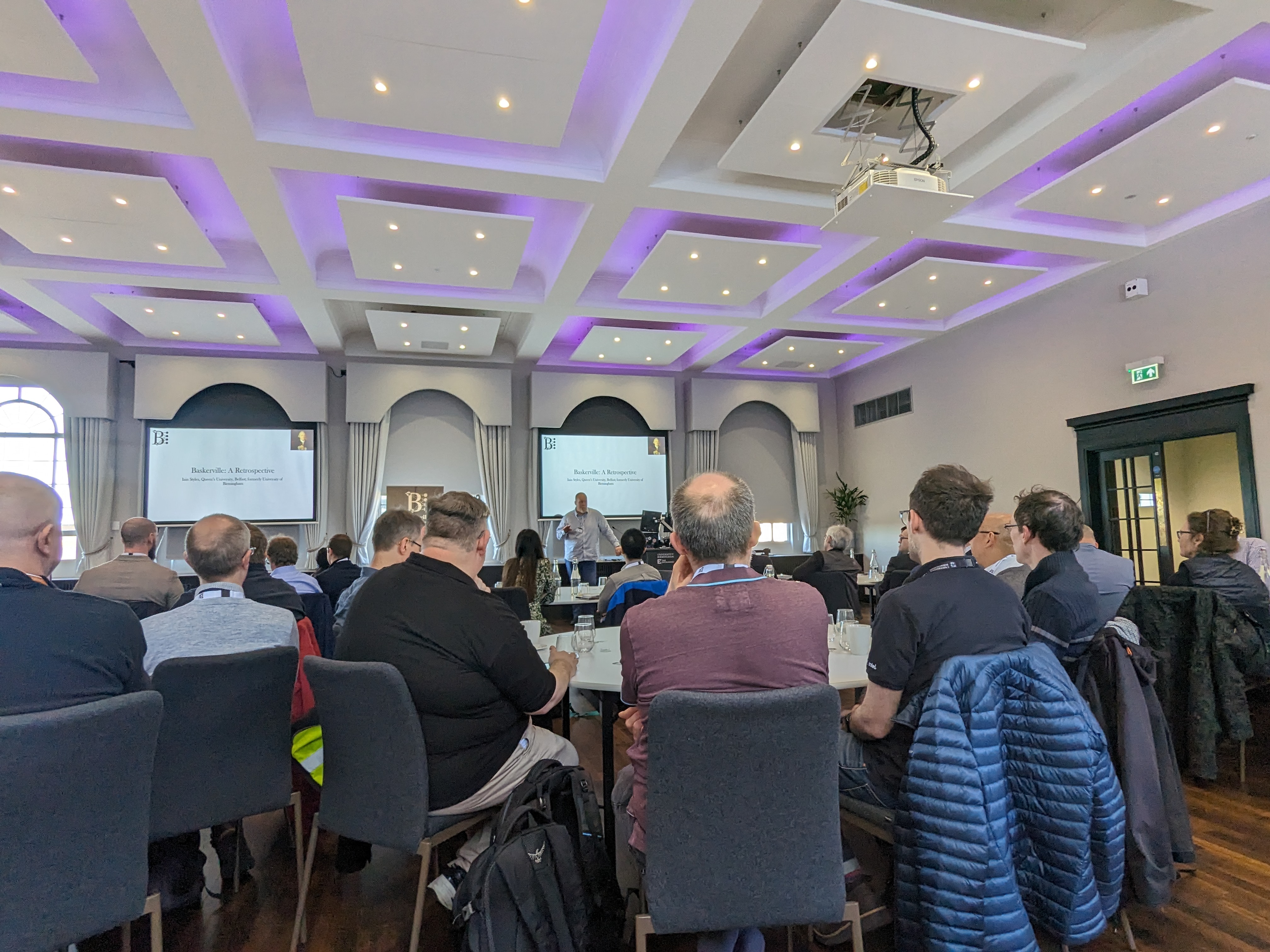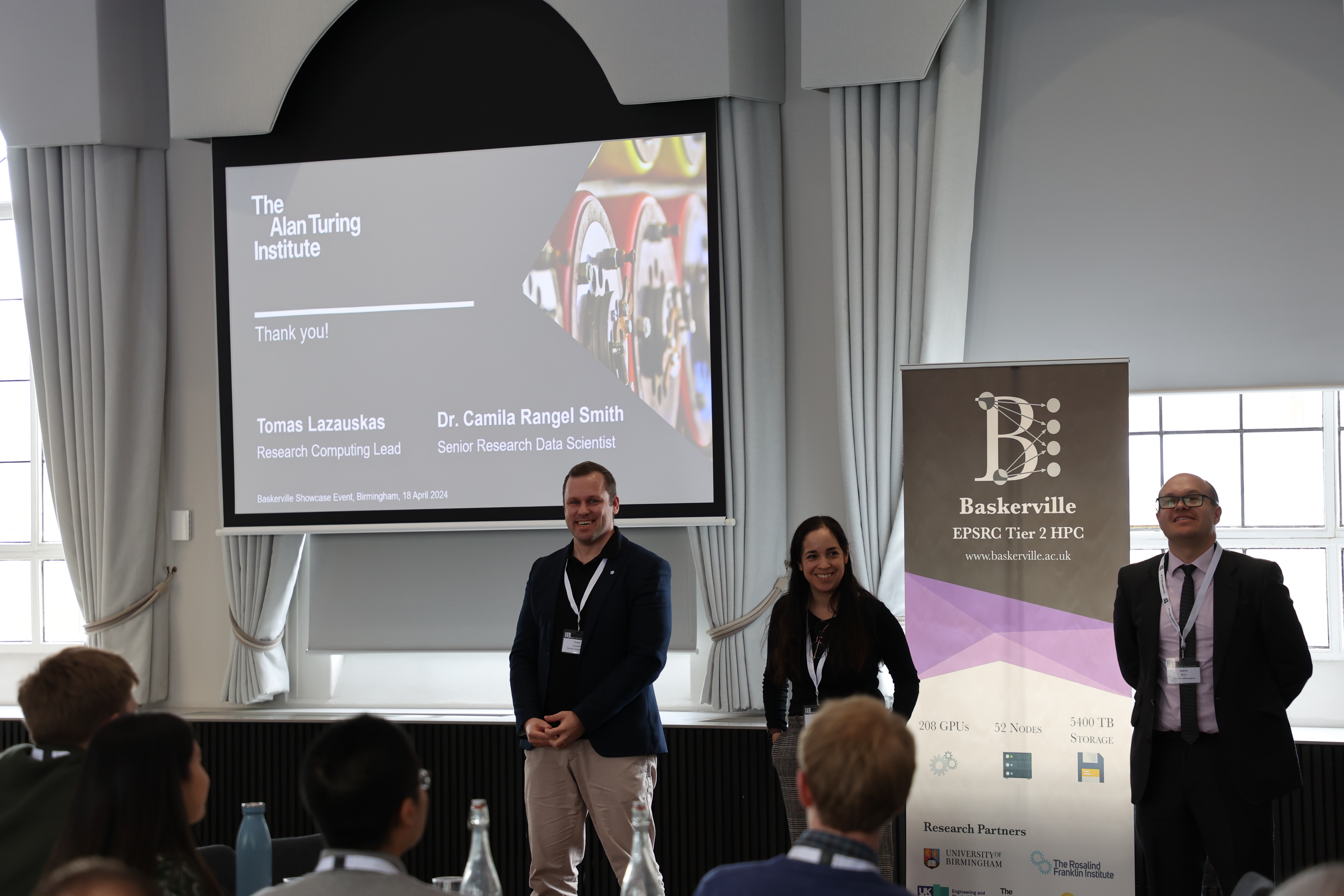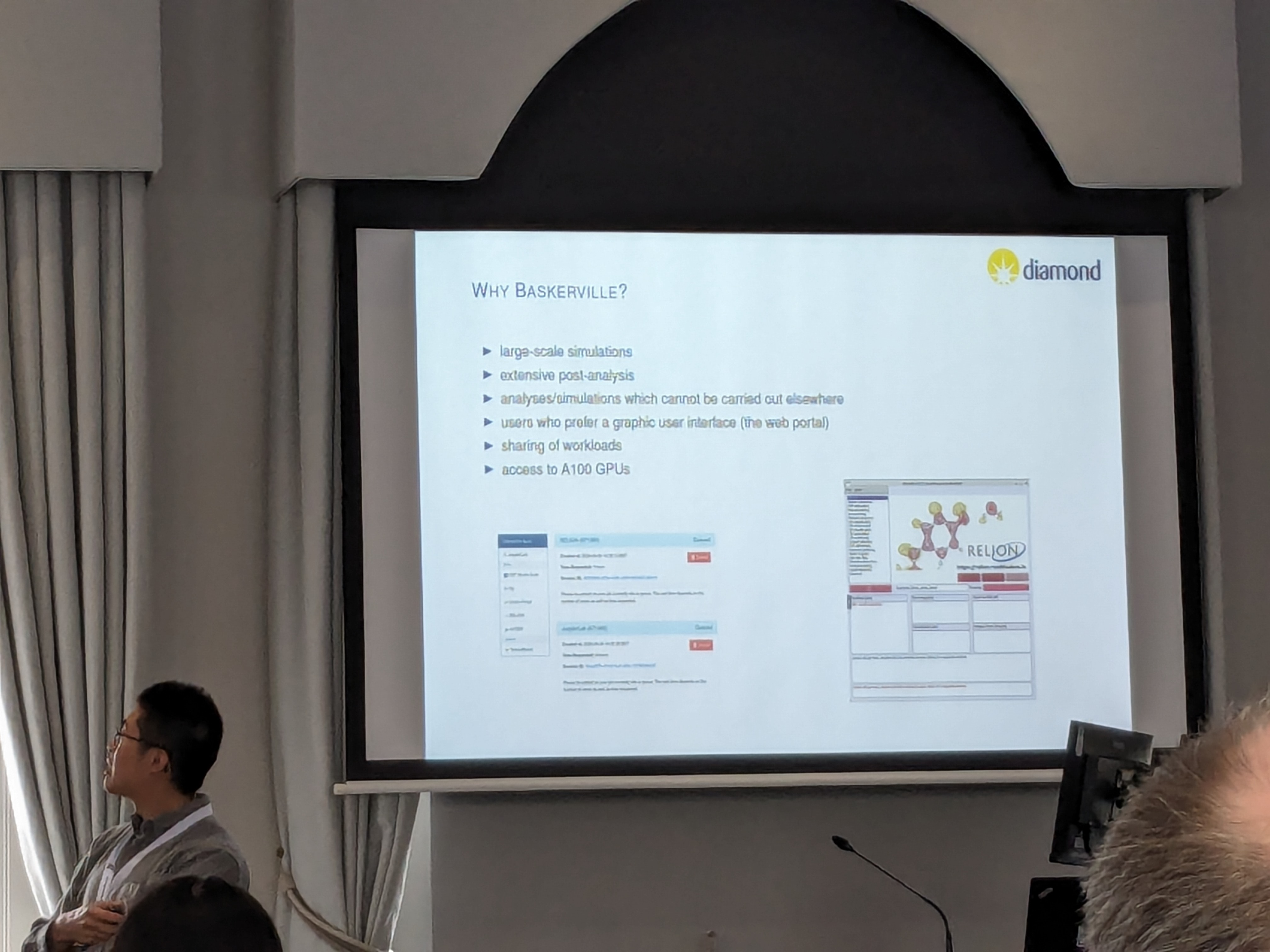Baskerville Showcase Event
18th April, 2024
On the 18th of April, 2024, we welcomed attendees from across the country and overseas to The Exchange, Birmingham, to hear about the varied research that has been enabled by Baskerville, the Tier 2 national supercomputer hosted at the University of Birmingham ranked 447th in the Top500 supercomputers.
Invited attendees included our technology partners in the project—OCF, Lenovo and NVIDIA—plus representatives from the Partner Institutes—Diamond Light Source, the Rosalind Franklin Institute, the Alan Turing Institute and our funder EPSRC, around 65 attendees in total. Each Partner Institute, as well as EPSRC Access to HPC users, gave talks on the research that had been conducted using Baskerville. We were delighted too to welcome Scott Tease, Vice-President & General Manager for HPC and AI at Lenovo, who made the trip from North Carolina, USA, to talk about sustainability in the AI Era.

The Pro-Vice Chancellor for Research, Rachel O’Reilly, kicked off the event by describing the research environment at the University of Birmingham and the University’s wider impact in the city. With 38,000 students and ~8,000 staff, almost 1 in every 50 jobs in Birmingham depends on the University. Rachel went on to introduce Advanced Research Computing, the team that runs Baskerville and BEAR, the Birmingham Environment for Academic Research.
Next up was Iain Styles, former Academic Lead of Baskerville, now based at Queen’s University, Belfast. Baskerville was designed back when there was only one AI-centric system (JADE) in the UK. When Baskerville was launched in 2021, it had the largest GPU capacity of the UK’s Tier 2 systems. The system is very popular with its users, often at 90% capacity and consistently over 80%. The current director, Andrew Morris, then gave more details about the use of Baskerville, with 475 current users over 133 projects, a number of publications, with more in preparation. The system has 52 compute nodes with 4 A100s each and 5400TB of storage.
It was then onto the first talk from a researcher to hear about the exciting projects made possible by Baskerville’s technology. Matthew Foulkes from Imperial College, London, is one of our biggest EPSRC users and described his group’s research into approximating many-electron wave functions using neural networks, in the field of physics. Matthew described the huge sums needing to be calculated within quantum mechanics for just a few electrons, and how they have been using neural networks to find quantum phase transitions. One example given was using computational modelling to investigate defects in fusion reactors. Matthew described Baskerville as a “wonderful resource for the UK, Baskerville was a light for us”.
Scott Tease then described the evolution of compute infrastructure and the measures that Lenovo are putting in place to make it more sustainable. Key to this is direct-to-node liquid cooling, which Birmingham was the first in the UK to use and continues to deploy as standard in its research data centre where Baskerville is housed. As well as providing highly efficient cooling, which becomes increasingly important as rack densities increase beyond 100kW, Lenovo aim to manufacture locally in Europe and ship many components via sea, rather than air (50x less CO₂). Other measures include re-using consumer plastics to create new products, and shipping servers ‘rack-ready’ to save around 48kg of cardboard and 88 linear metres of wood packaging per rack.

Our second EPSRC user, Barry Haddow, then described his research into multilingual natural language processing at scale. He talked about the evolution of large language models (LLM) over the years, and how important the quality of the prompt is when generating an answer. An important point to consider when using ChatGPT is how difficult it is to maintain LLM knowledge, e.g. keeping up with the changes of those in UK ministerial positions!

Tomas Lazauskas and Camila Rangel Smith then presented a broad range of research showing Baskerville’s impact at the Alan Turing Institute. Tomas reported that “Baskerville is highly valued for its ease of use, support and community engagement”, with a recent 2-day training workshop run by Baskerville Research Software Engineers (RSEs) resulting in a large uptake of new users. Projects benefitting from use of Baskerville range from AI-assisted monitoring of biodiversity, with training of a model to detect moth species, through to using Baskerville to train language models for music captioning e.g. determining emotions and tempo. Camila then described a project investigating protein structure where Baskerville came to the rescue with its high data storage and GPU capabilities.


After lunch, Steve Davey from NVIDIA gave an update on the underlying technology behind Baskerville and the future of GPUs, describing the new Grace GPU Superchip, which should double AI data centre throughput, providing the same resource for half the power. He also talked about Grace H200’s coming to the market in June, providing an increase of memory from 80GB for H100 up to 141GB.
Mark Basham showcased the research that Baskerville enables at the Rosalind Franklin Institute (RFI), where they apply physical science techniques to life sciences in a practical way on high risk, high reward projects. Baskerville is enabling researchers at the Institute to run lots of big molecular simulations. Large data transfer is required and using Globus, they were able to transfer 724TB to Baskerville in just four weeks. A medical project using GPU accelerated image analysis on Baskerville is Wellcome LEAP, where images of placentas are captured and then analysed to investigate the flow of nutrients and how that can affect the incidence of stillbirths. The RFI has increasing numbers of Baskerville users and due to its fair use policy, were able to use 50% of the system when it was quiet.
The last Partner Institute to speak was Diamond Light Source, a world-leading centre for synchrotron science. Timothy Poon described a range of projects using Baskerville, from the conservation of cultural heritage — investigating how ancient parchment degrades, through to health and disease studies around COVID-19. Researchers at Diamond use it for their large-scale simulations and extensive post-analysis, with a preference for using the Portal, which provides user-friendly, web-based access. Diamond were also appreciative of a 2-day training course that was provided on how to use RELION with Baskerville.

The last researcher talk was by Kit Windows-Yule from the University of Birmingham, presenting together with his PhD student, Leonard Nicusan. Kit and Leonard provided us with an interactive talk to help the diverse audience understand how multi-node sorting works, with the help of some tennis balls! Kit described the importance of understanding multi-node sorting, through using Baskerville’s interlink capabilities, and how by reducing sorting, computational expense and carbon emissions can be reduced. An applied example of this is where they are modelling particulate and multiphase systems to produce novel, biodegradable and recyclable plastics. Kit’s group performed benchmarking to evaluate whether it was worth using GPUs for their research and found that they gave an order of magnitude improvement, allowing acceleration of research into world-changing problems.

Andrew Morris concluded the event by thanking all the research and technology partners involved in Baskerville, EPSRC for funding the system, and members of the Advanced Research Computing for running and supporting Baskerville. Thanks were also given to all the speakers who gave such fascinating talks, highlighting the diverse range of research that Baskerville enables.